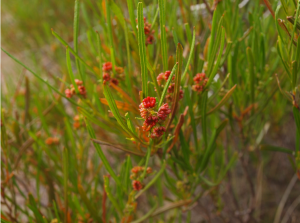This is a guest post by Matthew Christmas. Matthew is a PhD researcher under the supervision of Professor Andy Lowe.
Hopbush- the Aussie battler
 Widely distributed plants, such as the Australian native ‘hopbush’ (Dodonaea viscosa, right), have to face a spectrum of environmental conditions across their range. In the short term they can deal with environmental changes through non-permanent, ‘plastic’ shifts in their structure and physiology.
Widely distributed plants, such as the Australian native ‘hopbush’ (Dodonaea viscosa, right), have to face a spectrum of environmental conditions across their range. In the short term they can deal with environmental changes through non-permanent, ‘plastic’ shifts in their structure and physiology.
Over a longer, multi-generational time scale, they can adapt via changes to their genetic makeup, i.e. via natural selection. These genetic changes are selected for by the environment the plants find themselves in.
Under contemporary climate change, plants are experiencing ever-changing conditions. Genetic adaptation may prove key to their persistence in an uncertain future. For the hopbush, recent evidence suggests that the species is well equipped to adapt to a changing climate.
Surviving the elements
Hopbush is an Australian native shrub with a wide distribution throughout the continent, as well as overseas. Its ability to adapt to a diversity of habitat types and climates has made it a species of choice for studies of local adaptation and responses to climate.
In particular, its distribution along the Mount Lofty and Flinders Ranges in South Australia, where it is cool and wet in the south and hot and dry in the north, has been the focus of a number of recent research articles. Guerin, Wen, and Lowe (2012) demonstrated a shift to narrower leaves over space and time. Narrow leaves are thought to be an adaptation to warmer, drier climate.
Similarly, Hill et al. (2015) found increasing stomatal density (the number of stomatal pores for gas exchange found on the underside of leaves) in line with an increase in mean summer maximum temperature.
Genome reveals more adaptability
A new study, recently accepted for publication in the journal Molecular Ecology, has used novel genomic techniques to investigate selection and adaptation at the level of the genome. The study focussed on populations of hopbush distributed along a 700 km aridity gradient along the Mount Lofty and Flinders Ranges.
Leaf samples were collected from multiple individuals at 17 collection sites. Genetic variation across 970 targeted genes both within and among populations was measured. The researchers found that temperature and water availability had selected for different genetic variants along the gradient.
Genes shown to be under selection had a diversity of functions, including water use efficiency and adaptation to environmental stressors, such as temperature and salt. Findings in the current study provide potential links between the phenotypic variation observed in previous studies and the underlying genomic variation.
A number of the genes that showed significant associations with environment had functions relating to leaf shape and the development and function of stomata. These findings add to the growing body of research beginning to unveil the adaptive processes that have enabled this highly adaptable species to thrive in such a diversity of habitats and climates.


